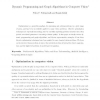Free Online Productivity Tools
i2Speak
i2Symbol
i2OCR
iTex2Img
iWeb2Print
iWeb2Shot
i2Type
iPdf2Split
iPdf2Merge
i2Bopomofo
i2Arabic
i2Style
i2Image
i2PDF
iLatex2Rtf
Sci2ools
PAMI
2011
2011
Dynamic Programming and Graph Algorithms in Computer Vision
Optimization is a powerful paradigm for expressing and solving problems in a wide range of areas, and has been successfully applied to many vision problems. Discrete optimization techniques are especially interesting, since by carefully exploiting problem structure they often provide non-trivial guarantees concerning solution quality. In this paper we briefly review dynamic programming and graph algorithms, and discuss representative examples of how these discrete optimization techniques have been applied to some classical vision problems. We focus on the low-level vision problem of stereo; the mid-level problem of interactive object segmentation; and the high-level problem of model-based recognition.
Discrete Optimization Techniques | Low-level Vision Problem | Operations Research | PAMI 2011 | Vision Problem |
| Added | 14 May 2011 |
| Updated | 14 May 2011 |
| Type | Journal |
| Year | 2011 |
| Where | PAMI |
| Authors | Pedro F. Felzenszwalb, Ramin Zabih |
Comments (0)

